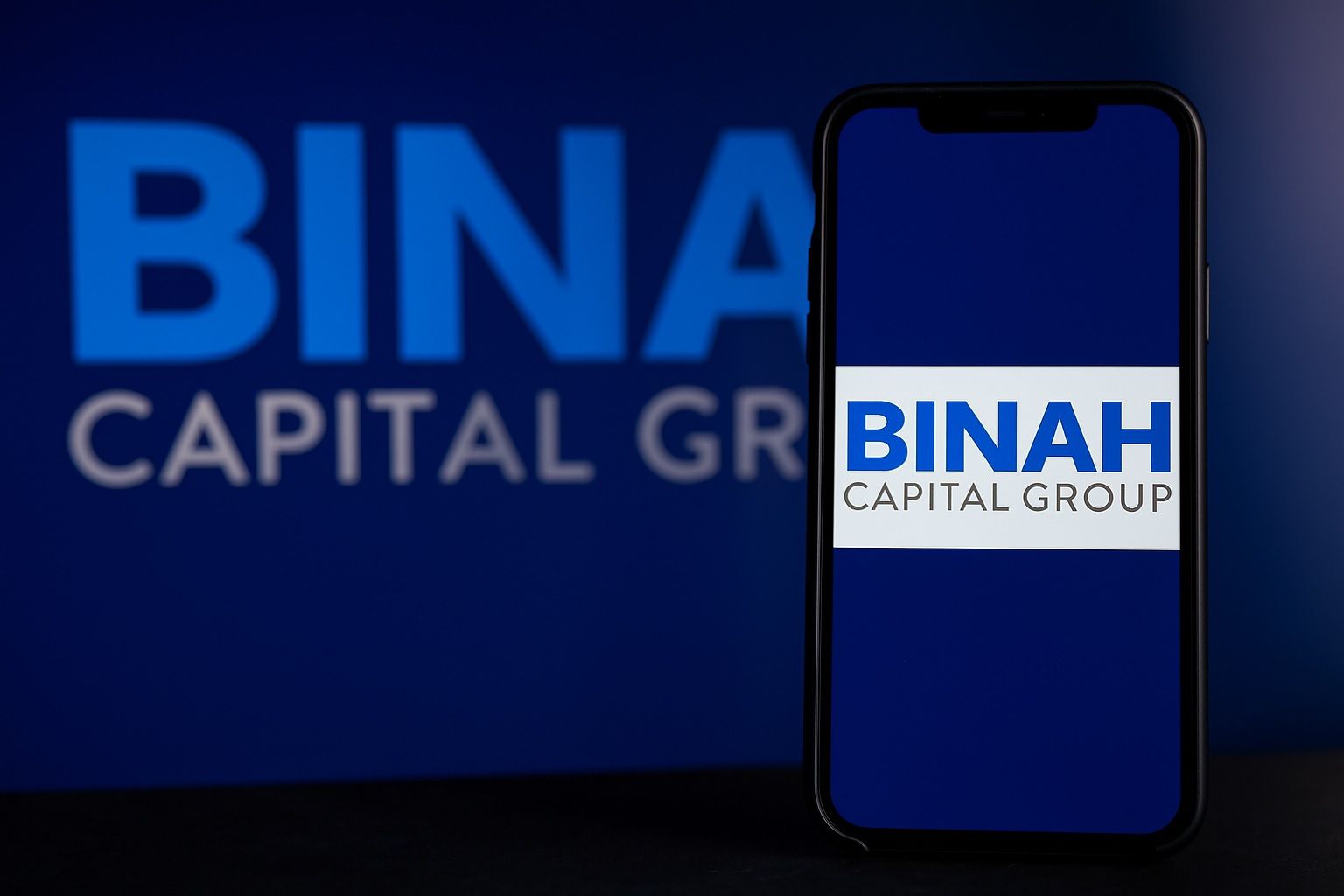Binah Capital Group, Inc. (NASDAQ: BCG) is back in the spotlight today after releasing stronger‑than‑expected third‑quarter 2025 results and triggering a sharp move in its thinly traded stock.
After the company reported double‑digit revenue growth, expanding margins, and a swing to GAAP profitability for the year to date, BCG shares spiked as much as ~75% in after‑hours trading on Thursday and continued to trade significantly higher in pre‑market action on Friday, November 14. [1]
Today’s key Binah Capital Group headlines (14 November 2025)
As of Friday, November 14, 2025, the main developments around Binah Capital Group are:
- Q3 2025 and first nine months results released
Binah reported Q3 2025 revenue of about $46.2 million, up roughly 9.5% year over year, and total revenue for the first nine months of 2025 of about $137 million, up 10% versus the same period in 2024. [2] - AUM milestone and profitability improvement
Total advisory and brokerage assets under management rose 11% year over year to $30.0 billion as of September 30, 2025. GAAP net income for the first three quarters reached $2.1 million, compared with a loss of $3.5 million a year earlier; Q3 alone delivered about $1.8 million in net income. [3] - EPS beat versus expectations
StreetInsider reported that BCG posted Q3 EPS of $0.08, topping consensus estimates by roughly $0.08 per share, with quarterly revenue confirmed at $46.2 million. [4] - Stock price reaction
According to StockAnalysis and MarketBeat data, BCG closed Thursday at around $1.43, then jumped above $1.70 in pre‑market trading on Friday after earnings, while Benzinga highlighted an after‑hours surge of roughly 75%, with the stock briefly trading around $2.49 on Thursday evening. [5] - Regulatory filings and SEC disclosure
An 8‑K filing and related materials were submitted to the SEC on November 13, 2025, furnishing the earnings press release and detailing results for the quarter ended September 30, 2025. [6]
All of this marks an important inflection point for a young public company that, until recently, was mostly associated with volatility, SPAC origins and a deeply discounted valuation.
What Binah Capital Group actually does
Binah Capital Group is a wealth management platform and broker‑dealer aggregator. Through a network of subsidiaries, it provides:
- Brokerage and advisory execution for stocks, bonds, ETFs and options
- Practice‑management support, supervision, compliance and accounting services for independent financial advisors
- Distribution of mutual funds, insurance products and alternative investments such as non‑traded REITs and annuities [7]
The company traces its roots to Wentworth Management Services, which was rolled into Binah via a SPAC merger with Kingswood Acquisition Corp. in 2024, giving Binah a Nasdaq listing and an initial asset base of roughly $23 billion in client assets. [8]
In simple terms, Binah’s business model is to aggregate independent broker‑dealers and hybrid RIAs, give them scale and technology, and then participate in the fees their advisors generate.
Q3 2025 by the numbers: growth plus margin expansion
The standout theme from Thursday’s earnings release is that Binah is now showing consistent top‑line growth with improving profitability.
Revenue and AUM
For the quarter and year‑to‑date period ended September 30, 2025, Binah reported: [9]
- Q3 total revenue: $46.2 million (vs. $42.2 million a year ago, +9.5%)
- Nine‑month 2025 revenue: approximately $137 million (vs. $124.3 million, +10%)
- AUM: $30.0 billion, up 11% year over year
Revenue is still largely driven by commissions and advisory fees. In Q3:
- Commissions: about $37.4 million (up from $34.8 million)
- Advisory fees: about $7.4 million (up from $6.2 million)
That mix underscores Binah’s positioning as a hybrid broker‑dealer/RIA platform: transactional commission business remains the largest line item, but advisory fees are growing faster and gradually increasing recurring revenue.
Net income and EPS: from red to black
Binah’s bottom line shows a notable shift from loss to profit: [10]
- Q3 2025 GAAP net income: ~$1.76 million, versus a $1.15 million loss in Q3 2024
- Nine‑month 2025 GAAP net income: ~$2.14 million, versus a $3.47 million loss in the prior‑year period
- Q3 EPS: $0.08 basic and diluted (vs. –$0.09 a year earlier)
- Nine‑month EPS: $0.06 (vs. –$0.30)
StreetInsider’s post‑earnings note framed the $0.08 figure as an approximately $0.08 beat versus expectations, a key reason traders reacted so aggressively in after‑hours and pre‑market sessions. [11]
EBITDA and cost discipline
On a non‑GAAP basis, management highlights EBITDA as a proxy for operating performance: [12]
- Q3 2025 EBITDA: $2.9 million (vs. $0.4 million in Q3 2024)
- Nine‑month 2025 EBITDA: $5.8 million (vs. $0.9 million a year earlier)
The improvement stems from both higher revenue and lower operating expenses:
- Total operating expenses in Q3 2025 were about $23.5 million, down from $26.0 million YoY, reflecting the absence of prior‑year one‑time costs tied to the business combination and public‑company transition. [13]
Taken together, the Q3 numbers suggest Binah is finally getting leverage from its platform after a costly transition year in 2024.
Market reaction: violent bounce after a brutal year
If you zoom out, today’s rally is happening against a very rough 12‑month backdrop for BCG shareholders.
Simply Wall St data shows: [14]
- The stock is down roughly 59% over the past year.
- It has dropped about 31% over the past month heading into earnings.
- Volatility is high, with average weekly moves around 12%, well above the broader U.S. market.
A separate Simply Wall St article on November 13 pointed to a 26% share price slide over the last month and a price‑to‑sales ratio near 0.1x, far below typical multiples in the U.S. capital‑markets peer group, as signs that sentiment had severely washed out. [15]
That context helps explain why the stock has reacted so dramatically to what, on the surface, are solid but not explosive financial results:
- A relatively small market cap of around $24 million and daily volumes under 100,000 shares mean order flow can move the price quickly. [16]
- After closing at roughly $1.43 on November 13, BCG traded as high as the mid‑$2s in after‑hours action following the earnings release, according to Benzinga and MarketBeat. [17]
Even after Friday’s pre‑market surge, the stock remains well below its 52‑week high of $6.00, underlining just how far it had fallen before this rebound. [18]
2025 so far: building a track record quarter by quarter
To understand whether Q3 is a one‑off surprise or part of a broader pattern, it’s useful to look at Binah’s results across all of 2025.
Q1 2025: strong start
In May, Binah reported: [19]
- Q1 2025 revenue: $49 million, up 18% year over year
- AUM: $26 billion, up 3%
- Net income: $1 million (swing from prior‑year loss)
- EBITDA: $2.2 million, with a notable reduction in operating expenses
Q2 2025: modest growth, still some losses
For Q2 2025, results were more mixed: [20]
- Revenue: $42 million, up about 2% year over year
- AUM: $28 billion, up 11%
- Net loss: around $0.7 million, similar to the prior year
- EBITDA: about $1.0 million, up 67% year over year
Put together, Q1–Q3 give a picture of:
- Steady revenue growth (high teens in Q1, low single digits in Q2, high single digits in Q3)
- Consistent AUM expansion from $26 billion to $30 billion over nine months
- A transition from net loss in 2024 (full‑year loss of $5.3 million on revenue of $169 million) to modest but positive net income year‑to‑date in 2025. [21]
For a recently listed consolidator in a heavily regulated industry, that progression is exactly what many investors wanted to see: growth, operating leverage, and at least the beginnings of consistent profitability.
Strategy: scaling an independent advisor platform
Binah positions itself as a “national broker‑dealer aggregator” and “hybrid‑friendly platform” for RIAs and independent advisors. [22]
Key elements of the strategy include:
- Acquiring or partnering with independent broker‑dealers and integrating them into a common infrastructure
- Providing advisors with technology, compliance and back‑office support, enabling them to focus on client relationships rather than operations
- Expanding advisory and fee‑based business, while still supporting traditional commission‑based models
Subsidiary PKS Investments—recently named one of Albany’s “Best Places to Work” for the second year in a row—gives Binah a foothold in the U.S. Northeast and serves as a proof point that the platform can attract and retain advisor talent in competitive markets. [23]
The Q3 results suggest this model is doing what it’s supposed to do: as AUM grows and advisors use more of Binah’s platform, revenue rises and fixed costs are spread over a larger base.
Balance sheet and risk factors
Even with improving earnings, Binah is still a small, leveraged financial company, and that comes with real risks.
Leverage and liquidity
As of September 30, 2025, the company reported: [24]
- Cash and cash equivalents: about $8.3 million
- Long‑term debt: roughly $18.2 million
- Total assets: $67.6 million
- TTM revenue: about $174 million
- TTM net loss: about $1.9 million (reflecting the drag from 2024 results)
While leverage is not unusual for financial‑services platforms, it does mean:
- Binah has less room for missteps if markets or advisor retention deteriorate.
- Interest expense—about $1.6 million for the first nine months of 2025—remains a meaningful drag on earnings. [25]
Regulatory and listing considerations
In May 2024, Binah disclosed that it had received a Nasdaq non‑compliance notice related to a delayed Form 10‑Q filing and was required to submit a plan to regain compliance. [26]
Subsequent updates and the company’s continued listing on Nasdaq suggest that management has been actively addressing these issues, but regulatory filings emphasize that ongoing compliance with Nasdaq listing rules and SEC reporting requirements remains a critical risk factor.
Investors should keep an eye on:
- Future 10‑Q and 10‑K filings for any additional disclosure around listing status
- Potential reverse split or capital actions if the share price remains under sustained pressure
Valuation snapshot: still cheap, even after the bounce?
Even after today’s move, Binah trades at levels that many observers would still consider distressed for a going‑concern financial platform:
- Market cap around $24 million
- Trailing‑12‑month revenue about $174 million
- Implied price‑to‑sales ratio of roughly 0.1–0.14x, per Simply Wall St and StockAnalysis. [27]
At the same time:
- The business just posted positive GAAP net income year‑to‑date
- AUM has reached $30 billion, and EBITDA has moved decisively higher
That combination—improving fundamentals plus a low multiple—is precisely what has drawn in speculative money and short‑term traders around this earnings release. Whether longer‑term institutional capital follows will likely depend on Binah demonstrating that:
- Profitability is sustainable across cycles
- Advisor retention and AUM growth remain solid
- Leverage and regulatory issues are contained and well‑managed
What today’s news could mean for current and prospective BCG investors
For existing shareholders, Q3 2025 offers something they haven’t had much of since the SPAC merger: evidence that the business is moving in the right direction.
Key takeaways:
- Execution is improving – Three consecutive quarters of revenue growth and rising EBITDA suggest the platform strategy is gaining traction. [28]
- The business has flipped to profitability year‑to‑date, even though trailing 12‑month earnings are still slightly negative. [29]
- The stock’s violent rally underscores ongoing volatility typical of small‑cap financials with limited float and intense retail interest. [30]
For potential investors watching from the sidelines, the story is more nuanced:
- On one hand, valuation remains low relative to sales and AUM, and Q3 results show clear progress. [31]
- On the other, regulatory, leverage and execution risks remain elevated, and the stock’s history of big swings—up and down—means position sizing and risk management are critical. [32]
Important: This article is for informational purposes only and does not constitute financial advice, investment recommendation, or a solicitation to buy or sell any security. Always do your own research and consider consulting a licensed financial professional before making investment decisions.
References
1. stockanalysis.com, 2. www.globenewswire.com, 3. www.globenewswire.com, 4. www.streetinsider.com, 5. stockanalysis.com, 6. www.sec.gov, 7. stockanalysis.com, 8. stockanalysis.com, 9. www.globenewswire.com, 10. www.globenewswire.com, 11. www.streetinsider.com, 12. www.globenewswire.com, 13. www.globenewswire.com, 14. simplywall.st, 15. simplywall.st, 16. stockanalysis.com, 17. www.benzinga.com, 18. stockanalysis.com, 19. www.globenewswire.com, 20. www.finanznachrichten.de, 21. www.globenewswire.com, 22. www.globenewswire.com, 23. www.globenewswire.com, 24. www.globenewswire.com, 25. www.globenewswire.com, 26. www.prnewswire.com, 27. stockanalysis.com, 28. www.globenewswire.com, 29. www.globenewswire.com, 30. www.benzinga.com, 31. simplywall.st, 32. simplywall.st








